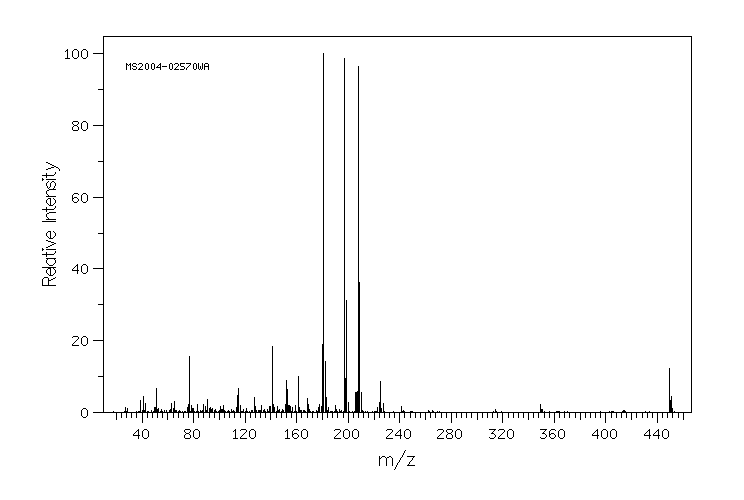lambda-cyhalothrin | 68085-85-8
-
物化性质
-
计算性质
-
ADMET
-
安全信息
-
SDS
-
制备方法与用途
-
上下游信息
-
文献信息
-
表征谱图
-
同类化合物
-
相关功能分类
-
相关结构分类
物化性质
-
熔点:<10 °C
-
沸点:187-190 °C(Press: 0.2 Torr)
-
密度:1.25 g/cm3(Temp: 25 °C)
-
闪点:2 °C
-
溶解度:可溶于氯仿(少许)、DMSO(少许)
-
物理描述:Cyhalothrin is a colorless solid. Insoluble in water. Used as a wide spectrum insecticide.
-
颜色/状态:Viscous liquid yellow-brown
-
气味:Mild
-
蒸汽压力:1.1X10-6 mm Hg at 25 °C (est)
-
稳定性/保质期:
Stable to decomp & cis-trans isomerization for at least 4 yr in the dark at 50 °C. Stable to light; loss on storage in the light is < 10% in 20 months. Decomposes at 275 °C. Slowly hydrolyzed by water in sunlight at pH 7-9, more rapidly at pH >9.
-
分解:Decomposes at 275 °C
-
折光率:Index of refraction: 1.534 at 24 °C/D
-
保留指数:2579.6;2552.2;2574;2516.3;2536.2;2571.5;2572;2574;2596;2597
计算性质
-
辛醇/水分配系数(LogP):6.1
-
重原子数:31
-
可旋转键数:7
-
环数:3.0
-
sp3杂化的碳原子比例:0.3
-
拓扑面积:59.3
-
氢给体数:0
-
氢受体数:7
ADMET
安全信息
-
危险等级:6.1(b)
-
危险品标志:Xn,F
-
安全说明:S26,S36/37
-
危险类别码:R11
-
WGK Germany:2
-
危险品运输编号:UN 2902
-
RTECS号:GZ1227780
-
海关编码:2926909010
-
包装等级:III
-
危险类别:6.1(b)
SDS
制备方法与用途
纯品为白色固体,黄色至棕色粘稠油状液体(工业品),沸点在187-190℃/0.2mmHg之间,蒸气压约0.001mPa(20℃),密度1.25(25℃)。水中溶解度为0.004ppb(20℃),溶于丙酮、二氯甲烷、甲醇、乙醚、乙酸乙酯、己烷和甲苯,浓度均大于500g/L(20℃)。50℃下存放两年不分解,光照下稳定,但在275℃时会分解。光线下pH在7-9区间缓慢分解,pH超过9则加速分解。该物质易溶于多种有机溶剂,如丙酮、甲醇、醋酸乙酯和甲苯等,且溶解度均大于500g/L;不溶于水。常温下可稳定储存半年以上,在水中日光下的半衰期为20天,在土壤中的半衰期则在22~82天之间。
作用特点氯氟氰菊酯又称三氟氯氟氰菊酯、功夫菊酯,是一种高效的广谱速效拟除虫菊酯类杀虫、杀螨剂。它通过抑制昆虫神经轴突部位的传导来发挥药效,具有趋避、击倒及毒杀的作用。其杀虫谱广泛,活性高且药效迅速,喷洒后能耐雨水冲刷,但长期使用容易产生抗性。对刺吸式口器害虫和螨类有一定防效;作用机制与氰戊菊酯、氟氰菊酯相似,区别在于它对螨虫有较好的抑制作用,在螨虫发生初期使用可以有效控制其数量增长,但在大量螨虫出现时则难以发挥作用,因此主要用于兼治虫螨。
药效用途氯氟氰菊酯是一种高效、广谱、速效的拟除虫菊酯类杀虫、杀螨剂,主要通过触杀和胃毒作用来发挥效果,无内吸作用。它对鳞翅目、鞘翅目和半翅目等多种害虫及其他害虫有效,尤其是叶螨、锈螨、瘿螨、跗线螨等。在昆虫和螨类并发时可以兼治。可防治棉红铃虫和棉铃虫、菜青虫、菜缢管蚜、茶尺蠖、茶毛虫、茶橙瘿螨、叶瘿螨、柑橘叶蛾、橘蚜以及柑橘叶螨、锈螨、桃小食心虫及梨小食心虫等。也可用于防治多种地表和公共卫生害虫,例如棉红铃虫、棉铃虫在第二、三代卵盛期时使用2.5%乳油1000~2000倍液喷雾,兼治红蜘蛛、造桥虫、棉盲蝽;菜青虫、菜蚜分别以6~10mg/L和6.25~12.5mg/L的浓度喷雾;柑橘潜叶蛾则使用4.2~6.2mg/L浓度喷雾。
用途高效氯氟氰菊酯是氯氟氰菊酯16个立体异构体中杀虫活性最高的一对异构体。该产品以触杀和胃毒作用为主,并有一定的驱避作用,具有广谱、高药效、安全、持效期长且耐雨水冲刷的特点,易生物降解,降解后不产生有毒残留物。它能有效防治多种鳞翅目幼虫并可控制某些地下害虫,并对某些成虫有拒避作用。
用途本品是一种新型拟除虫菊酯类杀虫剂,具有触杀和胃毒作用,无内吸作用,杀虫谱广且杀虫迅速,持效期长。广泛用于防治棉花、果树、大豆、蔬菜等作物上的鳞翅目、鞘翅目和同翅目的害虫。
类别农药
毒性分级高毒
急性毒性口服-大鼠LD50: 144毫克/公斤
可燃性危险特性 储运特性库房通风低温干燥;与食品原料分开储运
灭火剂干粉、泡沫、砂土
上下游信息
反应信息
-
作为反应物:参考文献:名称:Production process of gamma-cyhalothrin摘要:制备γ-氰戊菊酯的过程包括:a)将1R顺式-Z 3-(2-氯-3,3,3-三氟丙烯基)-2,2-二甲基环丙烷羧酸氯化生成1R顺式-Z 3-(2-氯-3,3,3-三氟丙烯基)-2,2-二甲基环丙烷羧酸氯化物;b)在氰化物源的存在下,用3-苯氧基苯甲醛酯化1R顺式-Z 3-(2-氯-3,3,3-三氟丙烯基)-2,2-二甲基环丙烷羧酸氯化物,形成一个立体异构体混合物的氰戊菊酯异构体;c)在最不溶的立体异构体从溶液中结晶的条件下对立体异构体混合物进行外消旋。公开号:US07468453B2
-
作为产物:参考文献:名称:AGRICULTURAL CHEMICALS摘要:本发明涉及与农业领域中已知有用的化合物衍生物。这些衍生物通过成为活性化合物的氧化还原衍生物而与母体活性化合物区分开来。这意味着活性化合物中的一个或多个官能团已经转化为另一个官能团,其中一个或多个转变可能被认为代表相对于原始化合物中的官能团的氧化状态的变化。我们通常将这些化合物称为氧化还原衍生物。这些化合物可用作杀虫剂、除草剂和驱虫剂。公开号:US20150094474A1
文献信息
-
[EN] ACC INHIBITORS AND USES THEREOF<br/>[FR] INHIBITEURS DE L'ACC ET UTILISATIONS ASSOCIÉES
-
[EN] BICYCLYL-SUBSTITUTED ISOTHIAZOLINE COMPOUNDS<br/>[FR] COMPOSÉS ISOTHIAZOLINE SUBSTITUÉS PAR UN BICYCLYLE申请人:BASF SE公开号:WO2014206910A1公开(公告)日:2014-12-31The present invention relates to bicyclyl-substituted isothiazoline compounds of formula (I) wherein the variables are as defined in the claims and description. The compounds are useful for combating or controlling invertebrate pests, in particular arthropod pests and nematodes. The invention also relates to a method for controlling invertebrate pests by using these compounds and to plant propagation material and to an agricultural and a veterinary composition comprising said compounds.本发明涉及公式(I)中变量如索权和说明中所定义的自行车基取代异噻唑啉化合物。这些化合物对抗或控制无脊椎动物害虫,特别是节肢动物害虫和线虫方面具有用途。该发明还涉及一种通过使用这些化合物来控制无脊椎动物害虫的方法,以及包含所述化合物的植物繁殖材料、农业和兽医组合物。
-
[EN] AZOLINE COMPOUNDS<br/>[FR] COMPOSÉS AZOLINE申请人:BASF SE公开号:WO2015128358A1公开(公告)日:2015-09-03The present invention relates to azoline compounds of formula (I) wherein A, B1, B2, B3, G1, G2, X1, R1, R3a, R3b, Rg1 and Rg2 are as defined in the claims and the description. The compounds are useful for combating or controlling invertebrate pests, in particular arthropod pests and nematodes. The invention also relates to a method for controlling invertebrate pests by using these compounds and to plant propagation material and to an agricultural and a veterinary composition comprising said compounds.本发明涉及式(I)的噁唑啉化合物,其中A、B1、B2、B3、G1、G2、X1、R1、R3a、R3b、Rg1和Rg2如权利要求和描述中所定义。这些化合物对抗或控制无脊椎动物害虫,特别是节肢动物害虫和线虫方面具有用途。该发明还涉及一种利用这些化合物控制无脊椎动物害虫的方法,以及包括所述化合物的植物繁殖材料、农业和兽医组合物。
-
[EN] MICROBIOCIDAL OXADIAZOLE DERIVATIVES<br/>[FR] DÉRIVÉS D'OXADIAZOLE MICROBIOCIDES申请人:SYNGENTA PARTICIPATIONS AG公开号:WO2017157962A1公开(公告)日:2017-09-21Compounds of the formula (I) wherein the substituents are as defined in claim 1, useful as a pesticides, especially fungicides.式(I)的化合物,其中取代基如权利要求1所定义,作为杀虫剂特别是杀菌剂有用。
-
Thieno-pyrimidine compounds having fungicidal activity
表征谱图
-
氢谱1HNMR
-
质谱MS
-
碳谱13CNMR
-
红外IR
-
拉曼Raman
-
峰位数据
-
峰位匹配
-
表征信息







